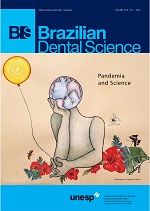Management of the maxillary sinus complications after dental implantation: a systematic review and meta-analysis
DOI:
https://doi.org/10.14295/bds.2020.v23i2.1929Abstract
Background and aim: Endoscopic sinus surgery owing to its satisfactory prognosis and low complication is considered as the first line of surgical procedure. Implant failure is often reported despite efforts in recent years. The purpose of this study was to review the factors leading to side effects in dental implantation of the maxillary sinus. Material and Methods: The systematic search was performed on electronic databases of MEDLINE, PubMed, Cochrane Library, Embase, ISI, Google scholar to find corresponding articles regarding dental literature during 2010 to 2019. Electronic title management was carried out by Endnote X9 software. Searches were based on the keywords of “dental implants”, “Implants”,” dental”,” maxilla”, “sinusitis”. Results: The searched potentially relevant titles and abstracts were related to 294 articles, 104 of which were excluded due to lack of study inclusion criteria. At last, 11 articles were included into the final analysis. Postoperative sinusitis was found in 78 patients within 9 articles among 1195 patients. The implant failure was reported in 136 cases and the sinus membrane perforation in 185 sinuses within 11 articles among 1372 sinus lift procedures. Conclusion: The findings showed that the risk factors of sinusitis after implant surgery were Schneiderian membrane rupture and preoperative sinusitis, as well as smoking and residual bone height were the parameters elevating the dental implant failure risk.
KEYWORDS
Sinusitis; Dental implants; Implant failure.
Downloads
References
Liberati A, Altman DG, Tetzlaff J, Mulrow C, Gøtzsche PC, Ioannidis JP, et al. The PRISMA statement for reporting systematic reviews and meta-analyses of studies that evaluate health care interventions: explanation and elaboration. PLoS medicine. 2009;6(7):e1000100.
Westover LM. Evaluation of the interface mechanical properties of craniofacial implants and natural teeth through development of the Advanced System for Implant Stability Testing (ASIST). 2016.
López-Quiles J, Melero-Alarcón C, Cano-Duran J, Sánchez-Martínez-Sauceda E, Ortega R. Maxillary sinus balloon lifting and deferred implantation of 50 osseointegrated implants: a prospective, observational, non-controlled study. International journal of oral and maxillofacial surgery. 2018;47(10):1343-9.
Aghaloo TL, Misch C, Iacono VJ, Wang H-L. Bone Augmentation of the Edentulous Maxilla for Implant Placement: A Systematic Review. International Journal of Oral & Maxillofacial Implants. 2016;31.
Chrcanovic BR, Kisch J, Albrektsson T, Wennerberg A. Survival of dental implants placed in sites of previously failed implants. Clinical oral implants research. 2017;28(11):1348-53.
Chen YW, Lee FY, Chang PH, Huang CC, Fu CH, Huang CC, et al. A paradigm for evaluation and management of the maxillary sinus before dental implantation. The Laryngoscope. 2018;128(6):1261-7.
Kozuma A, Sasaki M, Seki K, Toyoshima T, Nakano H, Mori Y. Preoperative chronic sinusitis as significant cause of postoperative infection and implant loss after sinus augmentation from a lateral approach. Oral and maxillofacial surgery. 2017;21(2):193-200.
Chirilă L, Rotaru C, Filipov I, Săndulescu M. Management of acute maxillary sinusitis after sinus bone grafting procedures with simultaneous dental implants placement–a retrospective study. BMC infectious diseases. 2016;16(1):94.
Guerrero JS. Lateral window sinus augmentation: Complications and outcomes of 101 consecutive procedures. Implant dentistry. 2015;24(3):354-61.
Vazquez JCM, de Rivera ASG, Gil HS, Mifsut RS. Complication rate in 200 consecutive sinus lift procedures: guidelines for prevention and treatment. Journal of Oral and Maxillofacial Surgery. 2014;72(5):892-901.
Soardi E, Cosci F, Checchi V, Pellegrino G, Bozzoli P, Felice P. Radiographic analysis of a transalveolar sinus‐lift technique: a multipractice retrospective study with a mean follow‐up of 5 years. Journal of Periodontology. 2013;84(8):1039-47.
Borges FL, Dias RO, Piattelli A, Onuma T, Gouveia Cardoso LA, Salomão M, et al. Simultaneous sinus membrane elevation and dental implant placement without bone graft: a 6‐month follow‐up study. Journal of periodontology. 2011;82(3):403-12.
Kim Y-K, Hwang J-Y, Yun P-Y. Relationship between prognosis of dental implants and maxillary sinusitis associated with the sinus elevation procedure. International Journal of Oral & Maxillofacial Implants. 2013;28(1).
Kim Y-K, Ahn K-J, Yun P-Y. A retrospective study on the prognosis of single implant placed at the sinus bone graft site. Oral surgery, oral medicine, oral pathology and oral radiology. 2014;118(2):181-6.
Nolan PJ, Freeman K, Kraut RA. Correlation between Schneiderian membrane perforation and sinus lift graft outcome: a retrospective evaluation of 359 augmented sinus. Journal of Oral and Maxillofacial Surgery. 2014;72(1):47-52.
Kim DY, Itoh Y, Kang TH. Evaluation of the Effectiveness of a Water Lift System in the Sinus Membrane‐Lifting Operation as a Sinus Surgical Instrument. Clinical implant dentistry and related research. 2012;14(4):585-94.
Kim JS, Choi SM, Yoon JH, Lee EJ, Yoon J, Kwon SH, et al. What Affects Postoperative Sinusitis and Implant Failure after Dental Implant: A Meta-analysis. Otolaryngology–Head and Neck Surgery. 2019;160(6):974-84.
Manor Y, Mardinger O, Bietlitum I, Nashef A, Nissan J, Chaushu G. Late signs and symptoms of maxillary sinusitis after sinus augmentation. Oral Surgery, Oral Medicine, Oral Pathology, Oral Radiology, and Endodontology. 2010;110(1):e1-e4.
Küçükkurt S. Evaluation of the survival of implant placement simultaneously with sinus augmentation: relationship in maxillary sinus pathologies. Oral radiology. 2019:1-13.
Pignataro L, Mantovani M, Torretta S, Felisati G, Sambataro G. ENT assessment in the integrated management of candidate for (maxillary) sinus lift. Acta otorhinolaryngologica italica. 2008;28(3):110.
Huang C-C, Wang C-H, Fu C-H, Huang C-C, Chang P-H, Chen Y-W, et al. Association between cigarette smoking and interleukin-17A expression in nasal tissues of patients with chronic rhinosinusitis and asthma. Medicine. 2016;95(47).
Strzelak A, Ratajczak A, Adamiec A, Feleszko W. Tobacco smoke induces and alters immune responses in the lung triggering inflammation, allergy, asthma and other lung diseases: a mechanistic review. International journal of environmental research and public health. 2018;15(5):1033.
Christensen DN, Franks ZG, McCrary HC, Saleh AA, Chang EH. A systematic review of the association between cigarette smoke exposure and chronic rhinosinusitis. Otolaryngology–Head and Neck Surgery. 2018;158(5):801-16.
Downloads
Published
How to Cite
Issue
Section
License
Brazilian Dental Science uses the Creative Commons (CC-BY 4.0) license, thus preserving the integrity of articles in an open access environment. The journal allows the author to retain publishing rights without restrictions.
=================




























